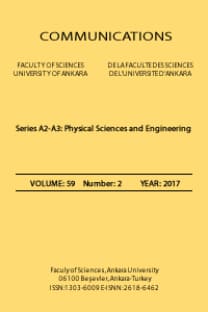VISUALLY ENHANCED SOCIAL MEDIA ANALYSIS OF REFUGEES IN TURKEY
social media, visual analysis, image features, refugees, Turkey
___
3rp:syria regional refugee response inter-agency information sharing portal. http://data.unhcr.org/syrianrefugees/country.php?id=224 (2018), accessed: 2018-01-19Alnafri, M.: Positions and declarations. Aljamal Press, Bagdad, Iraq, PP. 164, (1996).
Dahab, M.Y., Ibrahim, A., Al-Mutawa, R.: A comparative study on arabic stemmers. International Journal of Computer Applications 125(8) (2015)
UNHCR: United nations refugee agency. http://www.unhcr.org/ figures-at-a-glance.html (2017), accessed: 2018-01-19
Paltoglou, G., Thelwall, M.: Twitter, myspace, digg: Unsupervised sentiment analysis in social media. ACM Transactions on Intelligent Systems and Technology (TIST) 3(4), 66 (2012)
Pang, B., Lee, L., et al.: Opinion mining and sentiment analysis. Foundations and Trends R in Information Retrieval 2(1–2), 1–135 (2008)
Bulbul, A., Dahyot, R.: Populating virtual cities using social media. Computer Animation and Virtual Worlds 28(5) (2017)
Snavely, N., Seitz, S.M., Szeliski, R.: Photo tourism: exploring photo collections in 3d. In: ACM transactions on graphics (TOG). vol. 25, pp. 835–846. ACM (2006)
Snavely, N., Seitz, S.M., Szeliski, R.: Photo tourism: exploring photo collections in 3d. In: ACM transactions on graphics (TOG). vol. 25, pp. 835–846. ACM (2006)
Sang, E.T.K., Bos, J.: Predicting the 2011 dutch senate election results with twitter. In: Proceedings of the workshop on semantic analysis in social media. pp. 53–60. Association for Computational Linguistics (2012)
Burnap, P., Gibson, R., Sloan, L., Southern, R., Williams, M.: 140 characters to victory?: Using twitter to predict the uk 2015 general election. Electoral Studies 41, 230–233 (2016)
Mascaro, C., Agosto, D., Goggins, S.P.: The method to the madness: The 2012 united states presidential election twitter corpus. In: Proceedings of the 7th 2016 International Conference on Social Media & Society. p. 15. ACM (2016)
Tumasjan, A., Sprenger, T.O., Sandner, P.G., Welpe, I.M.: Predicting elections with twitter: What 140 characters reveal about political sentiment. Icwsm 10(1), 178–185 (2010)
Darwish, K., Magdy, W., Zanouda, T.: Trump vs. hillary: What went viral during the 2016 us presidential election. In: International Conference on Social Informatics. pp. 143–161. Springer (2017)
Kutlu M, Darwish K, Elsayed T.: Devam vs. Tamam: 2018 Turkish Elections. arXiv preprint arXiv:1807.06655. (2018)
Gayo-Avello, D.: ” i wanted to predict elections with twitter and all i got was this lousy paper”–a balanced survey on election prediction using twitter data. arXiv preprint arXiv:1204.6441 (2012)
Kreis, R.: # refugeesnotwelcome: Anti-refugee discourse on twitter. Discourse & Communication 11(5), 498–514 (2017)
Rettberg, J.W., Gajjala, R.: Terrorists or cowards: negative portrayals of male syrian refugees in social media. Feminist Media Studies 16(1), 178–181 (2016)
Darwish, K., Magdy, W., Rahimi, A., Baldwin, T., Abokhodair, N.: Predicting online islamophopic behavior after# parisattacks. The Journal of Web Science 3(1) (2017)
Magdy, W., Darwish, K., Abokhodair, N., Rahimi, A., Baldwin, T.: # isisisnotislam or# deportallmuslims?: Predicting unspoken views. In: Proceedings of the 8th ACM Conference on Web Science. pp. 95–106. ACM (2016)
Schreck, T., Keim, D.: Visual analysis of social media data. Computer 46(5), 68–75 (2013)
Bulbul, A., Dahyot, R.: Social media based 3d visual popularity. Comput. Graph. 63(C), 28–36 (Apr 2017), https://doi.org/10.1016/j.cag. 2017.01.005
Sharma, V., Kumar, A., Agrawal, N., Singh, P., Kulshreshtha, R.: Image summarization using topic modelling. In: Signal and Image Processing Applications (ICSIPA), 2015 IEEE International Conference on. pp. 226–231. IEEE (2015)
Bulbul, A., Kaplan, C., Ismail, S.H.: Social media based analysis of refugees in turkey. In: BroDyn18: Workshop on Analysis of Broad Dynamic Topics over Social Media. pp. 35–40 (2018)
Esnek, F.: Basin ilan kurumu, hangi ilde ne kadar suriyeli var? iste il il liste. http://www.bik.gov.tr/ hangi-ilde-ne-kadar-suriyeli-var-iste-il-il-liste/ (2017), accessed: 2018-01-19
Lowe, D.G.: Distinctive image features from scale-invariant keypoints. International journal of computer vision 60(2), 91–110 (2004)
- ISSN: 1303-6009
- Yayın Aralığı: Yılda 2 Sayı
- Başlangıç: 2019
- Yayıncı: Ankara Üniversitesi
AN ENSEMBLE MODEL FOR COLLABORATIVE FILTERING TO INVOLVE ALL ASPECTS OF DATASET
PHOTOMETRIC AND SPECTROSCOPIC VARIABILITY OF A POSSIBLE β CEPHEI STAR; V960 TAU
VISUALLY ENHANCED SOCIAL MEDIA ANALYSIS OF REFUGEES IN TURKEY
Abdullah BÜLBÜL, Salah HAJ ISMAİL
Enhancement of a Low-Cost Intelligent Device for Improving Energy Efficiency in Buildings
Oğuzhan TİMUR, Kasım ZOR, Özgür ÇELİK, Ahmet TEKE
THE TRUE AND APPARENT ELLIPTICAL ORBITS OF A VISUAL BINARY STAR
ULTRAHIGH SENSITIVE REFRACTIVE INDEX SENSOR BASED ON TAPERED MULTICORE OPTICAL FIBER
Zinah Abbas AL-MASHHADANI, İsa NAVRUZ
MOVING OBJECT DETECTION AND CLASSIFICATION IN SURVEILLANCE SYSTEMS USING MOVING CAMERAS
Ozge MERCANOGLU SİNCAN, Hacer YALİM KELES, Suleyman TOSUN
INTERVIEW IN LAND CONSOLIDATION USING GENETIC ALGORITHM
Şifa ÖZSARI, Harun UĞUZ, Tayfun ÇAY
A REVIEW ON SYSTEM IDENTIFICATION IN POWER GENERATION SYSTEMS
